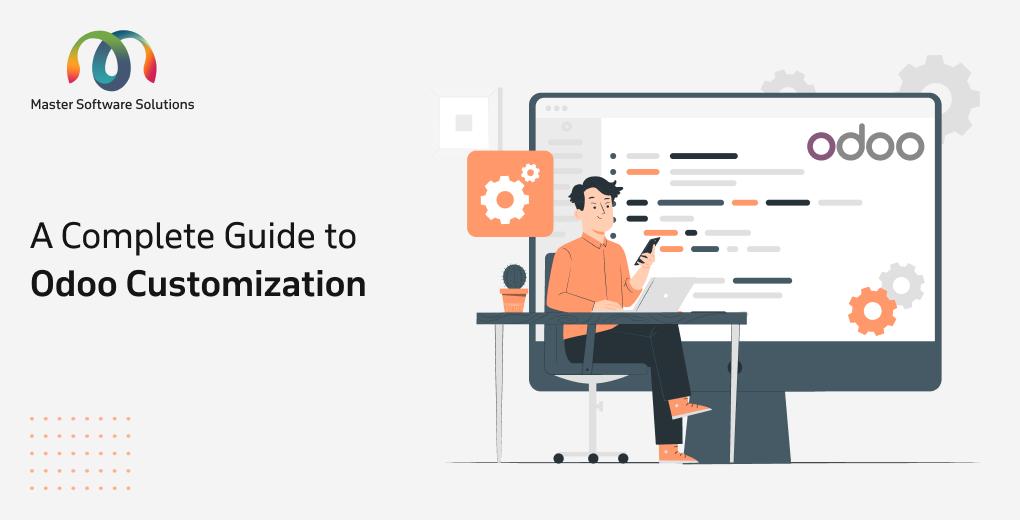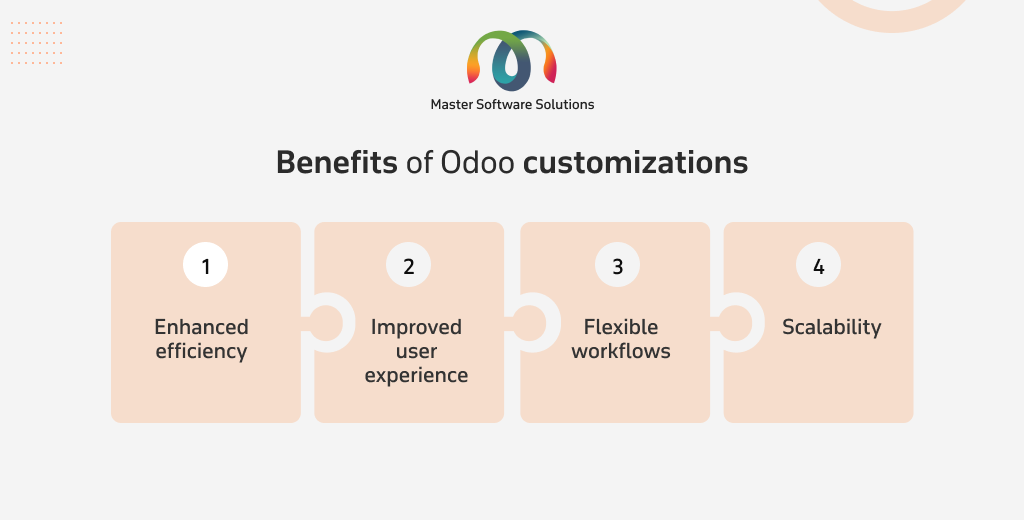You may wonder, “How can Odoo fit into most businesses?”
The Odoo enterprise resource planning platform is a suite of comprehensive business applications. Most businesses find Odoo a suitable option because of its adaptability, flexibility, and scalability. It is critical to tailor the system to the specific use case.
This blog explores the benefits of Odoo customization, how you can customize Odoo ERP, and how opting for Odoo customization services can help you.
Understanding Odoo customization
Odoo customization is the process of modifying functionalities, user interfaces, and other elements that fit your business requirements. This also includes workflow automation, integration with third-party systems, and adding new features.
Odoo is a highly customizable platform that allows you to tailor it to specific workflows and requirements, including creating custom automation. Customizing the platform can help you optimize operations, enhance efficiency, and address unique needs.
Benefits of Odoo customizations
Odoo ERP is designed and developed for businesses regardless of their size. It offers various features and functionalities that can help you streamline your operations. Odoo customizations can enhance these features and functionalities to fit your business. The benefits of Odoo customizations are:
Enhanced efficiency
Customizing Odoo enables the system to adapt to your needs, eliminate unnecessary steps, reduce manual data entry, and automate repetitive tasks. This can free your employees and allow them to work on more strategic tasks, boosting productivity and streamlining your operations.
Improved user experience
Odoo becomes more enjoyable when you customize it to fit your workflow or team’s operations. Odoo customizations can help simplify interfaces, highlight the most relevant information, and create workflows for your employees. This leads to increased user adoption, reduced training time, and fewer errors.
Flexible workflows
Every business is unique, and your system should be too. Odoo customization enables you to design workflows that match your needs. Rather than adapting to the system, Odoo adapts to your needs. You can create unique workflows, whether a sales process, a specific manufacturing flow, or a tailored project management process. Customization allows you to build Odoo around your way of doing things, offering a competitive edge.
Scalability
Odoo’s modular structure makes it a highly scalable system, as you can add or remove business applications based on your needs. This modular structure and its customisation abilities ensure the system can adapt with you. You can add new features, modify existing ones, and integrate with other business tools based on your needs. Customizations ensure that you don’t outgrow your system, which can lead to undertaking costly and disruptive system upgrades.
Getting started with Odoo customization
Seamless Odoo customizations need proper planning and strategizing. You should start by defining your goals, analyzing your business operations, and collaborating with an Odoo customization service company.
Clear objectives
Understand the reason you want to customize odoo. What are the problems you are trying to address? Or, what do you want to achieve with these customizations? Without these objectives being clear, you risk creating unfocused and inefficient customizations. Defining goals provides direction and a destination before starting the customization journey.
Business process analysis
Analyze your business processes and identify areas where customizations can add value. This includes understanding how different operations work, how the information flows, and places where bottlenecks or inefficiencies exist. Mapping out the processes enables you to pinpoint the exact area for customization, ensuring the system aligns with your business needs.
Team collaboration
Customization requires collaboration with various stakeholders, such as end-users, department heads, and IT personnel. Collaborating with people directly connected with the system enables you to understand their needs and perspectives. Open communications and feedback can help you create user-friendly and effective solutions and meet team requirements.
Setting the Odoo environment
Set your Odoo environment to bring your customizations into reality. These are the foundational steps for Odoo customizations.
Install Odoo
Install Odoo on your system. The installation process may vary based on your operating system and deployment method. Odoo offers installation documentation explaining various scenarios that can guide you in installing the system. A clean and stable Odoo installation is essential for a smooth development and customization.
Configure database
This is the next step. Configuring data includes creating and setting up the PostgreSQL database on which Odoo relies to store data. You provide details such as the database name, the administrator name, and the default language. A well-configured database ensures data integrity and efficient performance.
Install additional modules
While installing, the base Odoo provides the core features; you need to install additional modules based on your business needs. These modules include CRM, inventory, manufacturing, accounting, and more. You can browse and install business applications from the Odoo app store.
Key aspects of Odoo customizations
There are three primary ways you can tailor Odoo to fit your business. Odoo is a flexible platform that enables you to fine-tune existing functionalities, create a more user-friendly experience, or gain deeper insights.
Customizing Odoo modules
Odoo modules are the business applications, also referred to as the functional heart of Odoo. Customizing Odoo modules involves modifying existing features or adding entirely new ones to align with your business. It ranges from adding new fields to existing forms, changing the logic of automated workflows, creating new business rules, or developing a new module. To efficiently customize Odoo, you must be proficient in Python programming and the Odoo framework.
Customizing the Odoo interface
User interface and user experience are crucial for user adoption. This includes modifying views (forms, lists, or kanban boards), menus, dashboards, and user roles to present information. You can streamline navigation, highlight key data, and create a visually appealing and efficient workspace.
Customizing odoo reports
Reports are crucial to gain business performance insights. Odoo provides standard reports, but you can customize these or create new ones to extract the data you need for analysis. This involves modifying the layout, adding or removing fields, applying filters and aggregations, and creating custom charts and graphs. This empowers you to monitor key metrics, identify trends, and make data-driven decisions.
Advanced odoo customization techniques
Advanced customisations require specific knowledge and abilities. This section will explore these ways. Understanding these approaches can help significantly expand your Odoo customization capabilities.
Using Odoo Studio for customization
Odoo Studio is a powerful tool that Odoo offers. It is a no-code/low-code approach to customization. It provides a visual interface that allows you to create and modify modules, design custom forms and views, build automated workflows, and generate custom reports. The studio is great for quickly implementing common customizations, prototyping ideas, and providing self-service customizations. It offers drag-and-drop to build and modify aspects of your system.
Customization with Python and XML
This is where true Odoo customization potentials are unlocked. Python is the primary programming language used for Odoo’s backend logic. It allows you to create complex business rules, automate intricate processes, and integrate with external systems. XML can help you define the structure and presentation of Odoo’s data and user interface, including models, fields, views, and menus. An in-depth knowledge of Python and XML offers granular control over every aspect of Odoo, enabling you to build a highly bespoke system that perfectly fits your business.
Troubleshooting common Odoo customization issues
Addressing customization issues to ensure minimal disruption, efficiency, and stability is crucial. Dealing with customization errors and ensuring compatibility go hand in hand.
Dealing with customization errors
Errors in the customization process are bound to happen, and a systematic approach is the key to addressing them. Odoo tools for debugging:
- Log files – Learning to read and interpret log files is crucial to identify the source of issues. They provide traceback information, enabling you to recognize problematic code or configuration.
- Debugging tools – For Python customization, use a Python debugger. You can read your code line by line, inspect variables, and understand execution flow. Odoo offers a built-in developer tool that provides insights into system behavior.
- Error message – Pay close attention to error messages, as they can tell you about the nature of the problem.
- Community and documentation – Refer to the Odoo community forums and official documents. You find a similar issue discussed, which might help you.
Ensuring compatibility in customization
Odoo evolves constantly with regular updates. Ensuring that your customizations remain relevant with these updates is vital for long-term system health. Here are a few considerations:
- Implement Odoo best practices – Adhere to Odoo’s coding standards and best practices to ensure robust customizations. It includes using an official API, respecting inheritance rules, and avoiding direct modification of Odoo files.
- API changes – The APIs can change with each new Odoo version. Review release notes and developer documentation to adapt your customizations to new APIs.
- Test thoroughly after updates – Before you deploy the Odoo update to your production environment, test your customizations in a staging or development environment. This allows you to identify and address compatibility issues before they impact your live system.
- Carefully use Odoo Studio – Customizations using Odoo Studio have limitations in terms of long-term compatibility compared to Python or XML.
- Modular structure – Breaking your customization into well-defined, independent modules can make it easier to manage and update. This ensures that if one module has compatibility issues, it is less likely to affect other parts of your business.
How does Master Software Solutions help you with Odoo customizations?
Master Software Solutions offers end-to-end Odoo services, including Odoo customization services. We are a certified Ready partner with extensive Odoo knowledge and customization skills. Our Odoo customization services aim to increase productivity, improve user experience, and provide actionable insights. Book a call to discuss your Odoo customization needs and see how we can help you.

